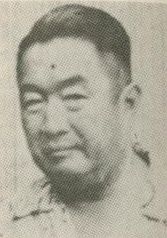
Georgio Eduardo Alberto Krugers was a cameraman and film director active in the Dutch East Indies during the early 20th century. He is recorded as having worked in film since the mid-1920s, and in 1927 he made his directorial debut, Eulis Atjih. He joined hajj pilgrims in 1928 and screened a resulting documentary, The Great Mecca Feast, in the Netherlands. His 1930 film Karnadi Anemer Bangkong is thought to be the first talkie in the cinema of the Indies, but was a commercial failure as the majority Sundanese audience considered it insulting. After making two works for Tan's Film in the early 1930s, Krugers moved to Hong Kong and then the Netherlands.

Njoo Cheong Seng was a Chinese-Indonesian playwright and film director. Also known by the pen name Monsieur d'Amour, he wrote more than 200 short stories, novels, poems and stage plays during his career; he is also recorded as directing and/or writing eleven films. He married four times during his life and spent several years travelling throughout Southeast Asia and India with different theatre troupes. His stage plays are credited with revitalising theatre in the Indies.

Fred Young was an ethnic Chinese film director and producer active in the Dutch East Indies and its successor state, Indonesia. He reportedly studied film in Hollywood as a youth, but only entered the nation's film industry in 1940. After he made his debut as a writer with Sorga Palsoe, he was involved in some 36 productions, 23 as director.

Siti Akbari is a 1940 film from the Dutch East Indies directed by Joshua and Othniel Wong and produced by Tan Khoen Yauw. Starring Roekiah and Rd Mochtar, it follows a couple while the husband commits adultery.

Kedok Ketawa is a 1940 action film from the Dutch East Indies. Union Films' first production, it was directed by Jo An Djan. Starring Basoeki Resobowo, Fatimah, and Oedjang, the film follows a young couple who fight off criminals with the help of a masked man.

Panggilan Darah is a 1941 film from the Dutch East Indies written and directed by Sutan Usman Karim and produced by Tjho Seng Han for Oriental Film. The black-and-white film starred Dhalia and Soerip as orphaned sisters trying to make a living in the colonial capital of Batavia before moving to Kudus to work at a clove cigarette factory.
Si Tjonat is a likely lost 1929 bandit film from the Dutch East Indies directed by Nelson Wong and produced by Wong and Jo Eng Sek. Based on the novel by F.D.J. Pangemanann, the silent film followed an indigenous man who, having killed his fellow villager, flees to Batavia and becomes a bandit. After kidnapping an ethnic Chinese woman, he is defeated and brought to justice.
Sorga Palsoe is a 1941 film from the Dutch East Indies which was directed by Tan Tjoei Hock for Java Industrial Film. The tragedy, starring Lo Tjin Nio, Tong Hui, Lim Poen Tjiaw, and Rohana, was a commercial failure. It is likely lost.

Mega Mendoeng is a black-and-white drama film from the Dutch East Indies directed by Boen Kin Nam and produced by Ang Hock Liem for Union Films. Starring Rd Soekarno, Oedjang, Boen Sofiati, and Soehaena, it follows two young lovers who are separated by lies but ultimately reunite at the village of Mega Mendoeng in Bogor. This film, Union's seventh and final production, was shot concurrently with Soeara Berbisa and completed over a period of three months. It was released in early 1942 and screened as late as July of that year, but may now be lost.
Tan Boen Soan was an ethnic Chinese Malay-language writer and journalist from Sukabumi, Java. He was the author of works such as Koetoekannja Boenga Srigading (1933), Bergerak (1935), Digdaja (1935) and Tjoban (1936). He later wrote for the Sunday Courier of Jakarta.

Union Films was a film production company located in Batavia, Dutch East Indies. Established by ethnic Chinese businessmen Ang Hock Liem and Tjoa Ma Tjoen in 1940, it produced seven black-and-white films before it was dissolved in 1942; all are thought to be lost. The company's films were directed by four men, mostly ethnic Chinese, and launched the careers of actors such as Rendra Karno and Djoewariah.

Oriental Film was a film production company in Batavia, Dutch East Indies. Established by ethnic Chinese businessman Tjo Seng Han in 1940, it completed four black-and-white films before it was closed in 1941. All the company's films were screened into the 1950s but may now be lost. They were directed by two men, Njoo Cheong Seng and Sutan Usman Karim, and launched the careers of actors such as Dhalia and Soerip.

Tan Tjoen Tiat, 2nd Majoor der Chinezen was a Chinese-Indonesian bureaucrat who served as the second Majoor der Chinezen, or Chinese headman, of Batavia, now Jakarta, capital of Indonesia. This was the most senior Chinese position in the colonial civil bureaucracy of the Dutch East Indies. As Majoor, Tan was also the Chairman of the Chinese Council of Batavia, the city's highest Chinese government body.
Keng Po was a Malay language Peranakan Chinese newspaper published in Batavia, Dutch East Indies from 1923 to 1958. During most of that time it was the second-most popular Malay-language Chinese newspaper in the Indies after Sin Po. It was also an important paper in the early period of Indonesian independence in the 1950s.
Kwee Kek Beng was a Chinese Indonesian journalist and writer, best known for being editor-in-chief of the popular Malay language newspaper Sin Po from 1925 to 1947.

Phoa Tjoen Hoat, who also published under the name Th. H. Phoa Sr., was a Chinese Indonesian, Malay language journalist, translator and newspaper editor active in the Dutch East Indies in the early twentieth century.











